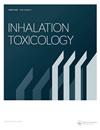检测和识别气溶胶中潜在吸入毒性的特定化学物质的程序
IF 2
4区 医学
Q4 TOXICOLOGY
引用次数: 1
摘要
摘要目的了解特征不佳的气溶胶的潜在吸入毒性具有挑战性,因为气溶胶可能含有大量化学物质,也因为很难预测在观察到的水平上哪些化学物质可能会引起严重的吸入毒性问题。我们开发了一种新的系统程序,通过二维气相色谱-飞行时间质谱(GC)的非靶向化学分析来应对这些挑战 × GC-TOFMS),并使用公开的毒性数据对结果进行评估,以根据潜在的吸入毒性对初步确定的检测化学品进行优先排序。材料和方法该程序涉及使用GC对气溶胶样品进行非靶向化学分析 × 选择GC-TOFMS是因为它是检测复杂样品中化学物质并根据质谱确定暂定身份的有效技术。对于数据评估,现有的毒性数据(例如来自美国环境保护局CompTox化学品仪表板)用于计算多种毒性指标,这些指标可以在初步确定的化学品之间进行比较。这些指标包括危险系数、癌症终生风险增量,以及与我们指定为暴露(毒理学终点)比率的危险系数类似的指标。结果和讨论我们通过检测、识别和优先考虑大麻钝剂机器吸烟产生的主流烟雾中潜在吸入毒性的特定化学物质,证明了我们程序的实用性。结论通过设计一种系统的方法来检测和鉴定复杂气溶胶样品中的多种化学物质,并根据不同的吸入毒理学终点对这些化学物质进行优先排序,我们开发了一种有效的方法来阐明气溶胶的潜在吸入毒性。本文章由计算机程序翻译,如有差异,请以英文原文为准。
A procedure to detect and identify specific chemicals of potential inhalation toxicity concern in aerosols
Abstract Objective Understanding the potential inhalation toxicity of poorly characterized aerosols is challenging both because aerosols may contain numerous chemicals and because it is difficult to predict which chemicals may present significant inhalation toxicity concerns at the observed levels. We have developed a novel systematic procedure to address these challenges through non-targeted chemical analysis by two-dimensional gas chromatography–time-of-flight mass spectrometry (GC × GC-TOFMS) and assessment of the results using publicly available toxicity data to prioritize the tentatively identified detected chemicals according to potential inhalation toxicity. Materials and Methods The procedure involves non-targeted chemical analysis of aerosol samples utilizing GC × GC-TOFMS, which is selected because it is an effective technique for detecting chemicals in complex samples and assigning tentative identities according to the mass spectra. For data evaluation, existing toxicity data (e.g. from the U.S. Environmental Protection Agency CompTox Chemicals Dashboard) are used to calculate multiple toxicity metrics that can be compared among the tentatively identified chemicals. These metrics include hazard quotient, incremental lifetime cancer risk, and metrics analogous to hazard quotient that we designated as exposure–(toxicology endpoint) ratios. Results and Discussion We demonstrated the utility of our procedure by detecting, identifying, and prioritizing specific chemicals of potential inhalation toxicity concern in the mainstream smoke generated from the machine-smoking of marijuana blunts. Conclusion By designing a systematic approach for detecting and identifying numerous chemicals in complex aerosol samples and prioritizing the chemicals in relation to different inhalation toxicology endpoints, we have developed an effective approach to elucidate the potential inhalation toxicity of aerosols.
求助全文
通过发布文献求助,成功后即可免费获取论文全文。
去求助
来源期刊

Inhalation Toxicology
医学-毒理学
CiteScore
4.10
自引率
4.80%
发文量
38
审稿时长
6-12 weeks
期刊介绍:
Inhalation Toxicology is a peer-reviewed publication providing a key forum for the latest accomplishments and advancements in concepts, approaches, and procedures presently being used to evaluate the health risk associated with airborne chemicals.
The journal publishes original research, reviews, symposia, and workshop topics involving the respiratory system’s functions in health and disease, the pathogenesis and mechanism of injury, the extrapolation of animal data to humans, the effects of inhaled substances on extra-pulmonary systems, as well as reliable and innovative models for predicting human disease.
 求助内容:
求助内容: 应助结果提醒方式:
应助结果提醒方式:


